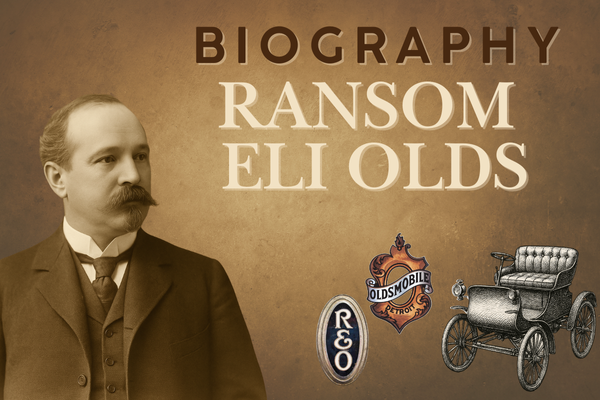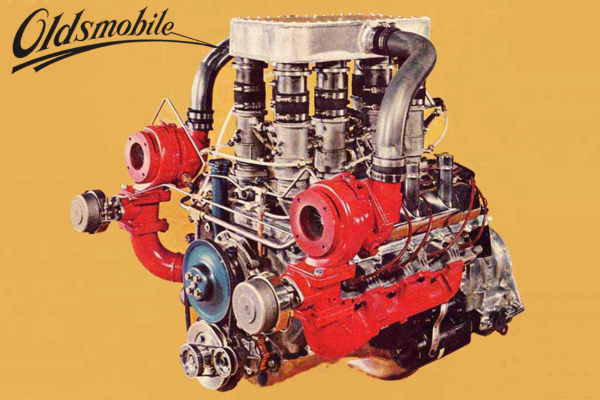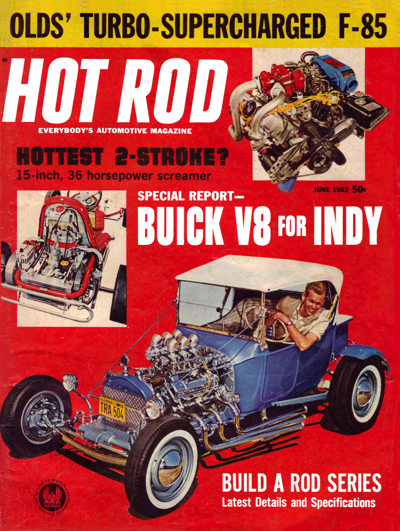General Year Information
For 1958, Pontiac featured all-new styling and adopted new chassis engineering. General appearance across the board included a honeycomb grille, a longer, lower silhouette, quad headlamps and taillamps, recessed floors, and concave rear fender panels. “Jewel tone Lucite” acrylic lacquer paint finish as standard and exclusive on Star Chiefs and Bonnevilles.
Bonneville became an upscale line over the Star Chief, however it rode on the smaller 122″ wheelbase chassis. It was no longer a single model designation in 1958. Gone was the 2-door hardtop Safari, with only the 4-door remaining.
To celebrate General Motors’ 50th anniversary this season, a special “Golden Jubilee” trim and paint finish package was announced in November. The color was coded “Z” with DuPont stock number 2865L. Special “Golden Jubilee” ornamentation was also applied to cars so finished.
Cars with fuel injection installed were trimmed with golden “Fuel Injection” in script on the upper front fenders and right side of deck lids. Cars with Tri-Power engines had horizontal “V” badges on the upper front fenders. A Tri-Power Bonneville convertible was selected as the Official Pace Car for the Indianapolis 500 Mile Race in May 1958.
Engine displacement rose again, this time to 370 CID – by increasing the bore to 4.0625″. Maximum horsepower was now at 330 for the top 3 2-barrel V-8. Fuel Injection was again offered. The Rochester fuel injection was a $500 option on any 1958 Pontiac. In late production a Borg-Warner heavy-duty police gearbox was optional. At least one car, built for racing at Daytona Beach, left the factory with a floor-mounted four-speed manual transmission. In March 1958, two NASCAR-certified ‘” extra horsepower Tempest 395-A” V-8s were released.
A total of 321 Pontiac chassis were delivered for professional car conversions this year. Of these, 320 were Series 27 chassis and one was a Series 28 chassis.
Model year production peaked at only 216,982 units, the worst of Pontiac’s post-war years. Within GM, combining the Oldsmobile and Pontiac lines was considered for a time
Chassis Information
- Wheelbase: Series 25 and 27 – 122″, Series 28 – 124″.
- Overall length: Series 25 – 211.7″, Series 27 station wagons – 210.5″, Series 28 – 214.5″.
- Front tread:(All) 58.8″.
- Rear tread: Rear tread: (All) 59.4″.
- Tires: Coupes and Sedans 8.00 x 14 Station wagons and all w/Air conditioning 8.50 x 14.
Models Offered
Chieftains could be identified by “Chieftain” in script at the front of concave insert panels on the rear doors or fenders and three stars on the rear fenders. Small hub caps were standard on all Chieftains, but many buyers opted for the optional full-wheel discs. Tail lamps were without trim rings on Chieftains, except for the new convertible offering.
The Convertible was in a separate series sharing a unique ribbed rear deck lid with Bonnevilles and was also longer than other Chieftains. “Princess” pattern Lustrex upholstery with Morrokide imitation leather trim was the interior finish for Chieftains, except the convertible, which had special “Seville-finish” Morrokide seats in “off-shoulder” combination patterns.
In 1958 the Super Chief nameplate now designated three cars on the long-wheelbase Star Chief chassis with two-barrel Chieftain V-8s as base engines. Identification features included full wheel discs, tail lamps with chrome rings, and rear fender coves decorated with “Super Chief” in script along with four stylized stars. DeLuxe steering wheels were part of the package.
The four-door sedan was upholstered in a blend of “Palisades” pattern Lustrex with “Plaza” pattern bolsters. Catalina hardtop buyers could choose either all-Morrokide or Morrokide and Lustrex trims at the same cost.
Pontiac’s Star Chiefs were the “Super Deluxe” models. Standard upholstery trim was “Tridimensional Prado” pattern Lustrex in the Catalina sedan with all-leather optional at no extra cost on both Catalinas. A roof rack, horizontal tailgate moldings, and distinct Safari gate scripts were featured on the Custom Safari. All other Star Chief models had the 124-inch wheelbase shared with the new Super Chiefs.
Identification features included “Star Chief” in script on front fenders, four stars within the concave insert panels, taillamp trim rings, and funnel-shaped decorative scoops at the front of the insert panels. These scoops were fitted with golden rectangular “V badges and triple wind-split moldings.
Chrome wheel discs were regular equipment along with a DeLuxe steering wheel and electric clock. Upholstery trim was “Tridimensional Prado” pattern Lustrex in the Catalina sedan with all-leather optional at no extra cost on both Catalinas. All-Star Chiefs boasted ‘stardust’ carpeting.
The distinctive four-door Custom Safari station wagon was still on the shorter Chieftain platform, but the two-door hardtop was gone. A roof rack. horizontal tailgate moldings and distinct “Safari”, in the script, was featured on this Custom Safari
Bonneville became a separate line in 1958. A convertible and “Sport Coupe” were offered. Base powerplants in Bonnevilles were the Star Chief V-8s, however, both cars were on the 122″ Chieftain wheelbase and used the same longer, ribbed rear decklid featured on the Chieftain convertible. This feature made the Series 25 Bonneville bodies slightly longer than the Series 27 models.
Identification features included “Bonneville” on the front fenders in script, “Bonneville” in block letters on hoods and rear deck, four bright metal chevrons on the lower front fender sides, four stars on the rear fender panels, and rocket-shaped, ribbed semi-cylindrical moldings at the front of the concave inserts.
Standard equipment included DeLuxe steering wheel, chrome wheel discs, and Bonneville-specific upholstery.
Engines
Chieftain & Super Chief with Manual Transmission. Overhead valves. Cast-iron block. Displacement: 370 CID. Bore and stroke: 4.0625″ x 3.5625″. Compression ratio: 8.6:1. Horsepower: 240 @ 4500. Torque: 354 @ 2600 RPM. Five main bearings. Hydraulic valve lifters. Camshaft Duration: Intake – 269°, Exhaust 270°, Overlap 49°, Lift 0.370″. Carburetor: Rochester 2GC two-barrel Model 7012703.
Bonneville, Star Chief & Safari with Manual Transmission. Overhead valves. Cast-iron block. Displacement: 370 CID. Bore and stroke: 4.0625″ x 3.5625″. Compression ratio: 8.6:1. Horsepower: 255 @ 4500. Torque: 360 @ 2600 RPM. Five main bearings. Hydraulic valve lifters. Camshaft Duration: Intake – 269°, Exhaust 270°, Overlap 49°, Lift 0.370″. Carburetor: Carter AFB four-barrel Model 2768S.
Chieftain & Super Chief with Hydramatic Transmission. Overhead valves. Cast-iron block. Displacement: 370 CID. Bore and stroke: 4.0625″ x 3.5625″. Compression ratio: 8.6:1. Horsepower: 255 @ 4500. Torque: 360 @ 2600 RPM. Five main bearings. Hydraulic valve lifters. Camshaft Duration: Intake – 273°, Exhaust 282°, Overlap 55°, Lift 0.400″. Carburetor: Carter AFB four-barrel Model 2740S.
Bonneville, Star Chief & Safari with Hydramatic Transmission. Overhead valves. Cast iron block. Displacement: 370 CID. Bore and stroke: 4.0625″ x 3.5625″. Compression ratio: 10.0:1. Horsepower: 285 @ 4600. Torque: 395 @ 2800 RPM. Five main bearings. Hydraulic valve lifters. Camshaft Duration: Intake 273°, Exhaust 282°, Overlap 55°, Lift 0.400″. Carburetor: Carter AFB four-barrel Model 2740S.
Optional “Extra Horsepower” V-8 – Available All Models. Overhead valves. Cast iron block. Displacement: 370 CID. Bore and stroke: 4.0625″ x 3.5625″. Compression ratio: 10.5:1. Horsepower: 300 @ 4600 RPM. Torque: 3400 @ 3000 RPM. Five main bearings. Hydraulic valve lifters. Camshaft Duration: Intake 273°, Exhaust 282°, Overlap 55°, Lift 0.400″. Carburetors: three 2-barrel Rochester carburetors Models: Front (all) 7011705 Center (manual trans) 7011709 (Hydramatic) 7011706 Rear (all) 7011707. Single-breaker ignition.
“Extra Horsepower” Fuel Injection – Available All Models. Overhead valves. Cast iron block. Displacement: 370 CID. Bore and stroke: 4.0625″ x 3.5625″. Compression ratio: 10.5:1. Horsepower: 310 @ 4800 RPM. Torque: 400 @ 3400 RPM. Five main bearings. Hydraulic valve lifters. Camshaft Duration: Intake 273°, Exhaust 282°, Overlap 55°, Lift 0.400″. Induction: Rochester mechanical fuel-injection Model 7014880.
“Extra Horsepower Tempest 395-A” V-8 – Available on All Models. Overhead valves. Cast iron block. Displacement: 370 CID. Bore and stroke: 4.0625″ x 3.5625″. Compression ratio: 10.5:1. Horsepower: 315 @ 5000 RPM. Torque: 400 @ 2800 RPM. Five main bearings. Hydraulic valve lifters. Camshaft Duration: Intake 283°, Exhaust 293°, Overlap 60°, Lift 0.411″. Carburetor: Carter AFB Model (manual trans) 2768S (Hydramatic trans) 2767S. Low-restriction dual exhausts, and dual-breaker ignition.
“Extra Horsepower Tempest 395-A” V-8 – Available 2-door Sedans & Hardtops. Overhead valves. Cast iron block. Displacement: 370 CID. Bore and stroke: 4.0625″ x 3.5625″. Compression ratio: 10.5:1. Horsepower: 330 @ 5200 RPM. Torque: 415 @ 3000 RPM. Five main bearings. Hydraulic valve lifters. Camshaft Duration: Intake 283°, Exhaust 293°, Overlap 60°, Lift 0.411″. Carburetors: three 2-barrel Rochester carburetors Models: Front (all) 7011705 Center (manual trans) 7011709 (Hydramatic) 7011706 Rear (all) 7011707. Low-restriction dual exhausts, Low-restriction dual exhausts and dual-breaker ignition.
More detailed information on the 1958 370 CID V8 engines may be found in the 1958 AMA Specifications Sheets. You may access the sheets HERE or use the navigation on the main page.
Engine Options and Availability
- The four-barrel V-8 could be installed as an option in Chieftains and Super Chiefs.
- Tri-Power carburetion on standard blocks was an $84 option for Chieftains and Super Chiefs and a $93.50 option on Star Chiefs and Bonnevilles. This was the “standard” Tri-Power setup, using three two-barrel Rochester carburetors, 10.5:1 cylinder heads, high-lift camshaft, and gave 300 horsepower.
- Rochester fuel injection was a $500 option on any 1958 Pontiac and this package included 10.5:1 cylinder heads and gave 310 horsepower. Approximately 200 Bonnevilles had this option.
- The Extra Horsepower Tempest 395-A “PK” option was $254 on Chieftains or Super Chiefs and $233 on Star Chiefs or Bonnevilles. It included a four-barrel carburetor, 10.5:1 cylinder heads, higher-lift camshaft, low-restriction dual exhausts for 315 horsepower
- The Extra Horsepower Tempest 395-A “PM” option was $331 on Chieftain and Super Chief and $320 on Star Chief and Bonneville and included 10.5:1 cylinder heads, higher-lift camshaft, low-restriction dual exhausts together with Tri-Power induction for 330 horsepower.
Power Train Options
Transmission and Axles
- A three-speed Synchromesh gearbox with column-mounted gear shift was the base price transmission.
- Four-speed Strato-Flight Hydra¬Matic was $231.34 extra.
- In late production a Borg-Warner heavy-duty police gearbox was optional.
- In Series 25, 210 had Synchromesh and 19,389 had Hydra-Matic.
- In Series 27, 6,943 had Synchromesh and 117,742 had Hydra-Matic.
- In Series 28, 258 had Synchromesh and 72,761 and Hydra-Matic.
- Rear-axle options included Safe-T-Track differential
- Rear axles had the following gear ratios: Hydra¬Matic 3.23:1, Optional Hydra-Matic 3.08:1, Synchromesh 3.42:1, Optional Synchromesh 3.64:1.
- Rear-axle dealer installed options 3.90:1 and 4.10:1.
Body Paint Color Codes
Click the Paint Name for Paint Mix Codes
Other Significant Options
- Air suspension ($175).
- Air-conditioning ($430).
- Bonneville bucket seats ($84).
- Brake-on light ($6).
- DeLuxe “Electromatic” radio ($161).
- DeLuxe radio ($102).
- DeLuxe steering wheel ($14).
- Dual exhaust ($31).
- Electric clock ($20).
- Electric contour wipers ($14).
- E-Z Eye Glass ($38).
- Foam seat ($13).
- Heater and defroster ($96).
- Oil filter ($10).
- Outside rearview mirror ($7).
- Padded dash ($19).
- Power antenna ($30).
- Power brakes ($38).
- Power seat ($77).
- Power steering ($108).
- Power windows ($108).
- Rear seat speaker $13.75 Bonneville and Star Chief
- Rear seat speaker $18.90 Chieftain/Super Chief
- Rear seat speaker $21 on Safari.
- Two-tone paint in standard colors ($27).
- Wheel discs ($18).
- White sidewall tires 8.00 x 14, 4-ply ($65).
- Windshield washer ($14).























